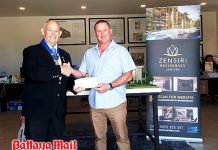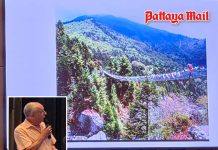Coronary artery disease (CAD) is the leading cause of death globally including Thailand. Given the diet that most Thais follow, you might think that this disease would be less of a problem in Thailand. You would be wrong as it is also the leading cause of death in Thailand. Why? Because tobacco smoking is a major risk factor for the disease and Thailand has a very high number of smokers.
This was a part of what the Pattaya City Expats Club members and guests learned at the Sunday, April 21 meeting when they listened to the talk given by Dr. Sujit Banyatpiyaphod, Thoracic Surgeon and Medical Director of the Heart Centre at Bangkok Hospital Pattaya.
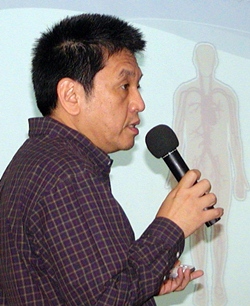 Dr Sujit Banyatpiyaphod, Thoracic Surgeon and Medical Director of the Heart Centre at Bangkok Hospital Pattaya, addresses the club on new findings and treatment of Coronary Artery Disease. Now it is possible to replace the heart lung machine used in complicated surgeries with ‘OPCAB’ or “off-pump coronary artery bypass”. With the OPCAB procedure, the heart is not stopped; instead, the surgical team is able to stabilise portions of the heart while the bypass work is being done.
Dr Sujit Banyatpiyaphod, Thoracic Surgeon and Medical Director of the Heart Centre at Bangkok Hospital Pattaya, addresses the club on new findings and treatment of Coronary Artery Disease. Now it is possible to replace the heart lung machine used in complicated surgeries with ‘OPCAB’ or “off-pump coronary artery bypass”. With the OPCAB procedure, the heart is not stopped; instead, the surgical team is able to stabilise portions of the heart while the bypass work is being done.
Dr. Sujit explained that cholesterol is one of the main causes of CAD. Our liver produces cholesterol which comes from consuming meat and dairy products. Cholesterol produces plaque in our arteries. As the plaque builds up, the artery walls become thicker. This can lead to blockages in the arteries. The medical term for thickening of the artery walls is “atherosclerosis.” There are two types of atherosclerotic plaque, Dr. Sujit explained; stable and vulnerable. Stable plaque is lipid-poor and has a thick fibrous cap. Vulnerable plaque is lipid-rich and has a thin fibrous cap. Vulnerable plaque is much more dangerous than stable plaque as build-up of vulnerable plaque can cause serious heart problems at any time.
Dr Sujit revealed that thickening of the artery walls can reduce the blood supply to the heart muscle. There are several medical terms for this, including “ischemic heart disease” and “myocardial infarctions (MI).” The symptoms of MI include discomfort in the chest (angina), arms, back, neck or jaw; trouble breathing; feeling light-headed; breaking out in a cold sweat; and feeling sick or discomfort in the stomach. He noted that the risk factors for MI include smoking, hypertension, high cholesterol, diabetes, obesity, lack of exercise and stress.
There are a number of non-invasive procedures to diagnose CAD, Dr Sujit said. They include an electrocardiogram (ECG or EKG), an exercise stress test, an echocardiogram (ultrasound), a CT scan and an MRI. Dr. Sujit explained that the ECG is not a very reliable test by itself because a normal reading on the test does not necessarily mean that you don’t have CAD. He said that the exercise stress test, which is 95% accurate, is far better. The most accurate method is through an invasive procedure called an angiogram (a catheter is inserted through an artery where a dye is released and extent and location of blockages can be identified).
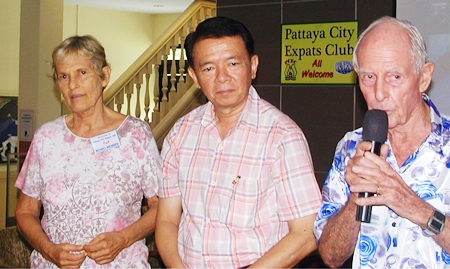 PCEC was fortunate to have the new Nai Amphur (District Chief) of Banglamung, Sakchai Tonghoh, come to meet the club, and to present teachers cards to PCEC’s many volunteer teachers. Past Chair Richard Smith introduces Sakchai, while current Chair Pat Koester looks on.
PCEC was fortunate to have the new Nai Amphur (District Chief) of Banglamung, Sakchai Tonghoh, come to meet the club, and to present teachers cards to PCEC’s many volunteer teachers. Past Chair Richard Smith introduces Sakchai, while current Chair Pat Koester looks on.
The initial treatment for this artery blockage is an angioplasty, which involves inserting a balloon-like device through the catheter into the portion of the artery where the walls are too thick, Dr Sujit explained. To prevent the artery from collapsing after the balloon is deflated, a stent is often inserted (a wire mesh that surrounds the balloon and expands and stays in place to hold the artery open).
If an angioplasty is not suitable to resolve the problem, Dr Sujit noted the treatment of choice is heart bypass surgery (a vein is taken from another part of the body and is grafted onto the artery to allow blood flow to bypass the blockage). The “old” method of doing bypass surgery involved stopping the heart for 1 to 2 hours; using a heart-lung machine to pump air into the lungs and to circulate blood while the bypass operation is performed. That method, which is about 50 years old, is used only rarely now because a new method is available, Dr Sujit said. It is called “off-pump coronary artery bypass” or “OPCAB.”
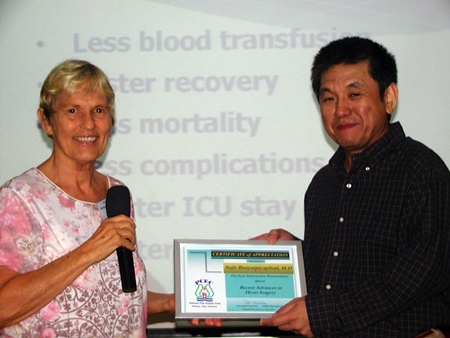 Chair Pat Koester presents Dr Sujit with a Certificate of Appreciation from Pattaya City Expats Club, for his interesting and informative talk.
Chair Pat Koester presents Dr Sujit with a Certificate of Appreciation from Pattaya City Expats Club, for his interesting and informative talk.
With the OPCAB procedure, the heart is not stopped. Instead, the surgical team is able to stabilise portions of the heart while the bypass work is being done. Dr Sujit explained that some of the advantages of the OPCAB procedure, compared to the heart-lung machine, are lower mortality, faster recovery, fewer complications, less blood transfusion needed, and lower cost.
In the Question and Answer session, Dr Sujit said that there is a new, robotic method available for bypass surgery, but that (a) it is extremely costly, and (b) it has some limitations. He mentioned that he was the first Surgeon in Thailand to perform this robotic surgery. His fields of interests include coronary bypass surgery; minimally invasive coronary artery bypass graft; minimally invasive mitral valve surgery; OPCAB; endoscopic radial artery; and saphenous vein harvest.
After the presentation, Master of Ceremonies Richard Silverberg updated everyone on upcoming events and called on Judith Edmonds to conduct the Open Forum, where questions are asked and answered about Expat living in Thailand.
For more information about the many activities of the Pattaya City Expats Club, visit their website at www. pattayacityexpatsclub.com.


